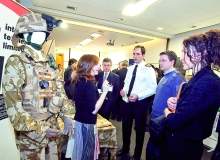
Mark Brierley: How does the work of the Centre for Defence Enterprise (CDE) fit in with the wider research goals of the Defence Science and Technology Laboratory (Dstl) and the Ministry of Defence (MoD)?
Jono Byrne: CDE, part of Dstl, exists to prove the value of novel, high-risk, high-potential-benefit research sourced from the broadest possible range of science and technology providers in order to develop cost-effective capability for UK Armed Forces and national security. CDE is a means to engage with, and set up research contracts with, the broadest possible supplier base.
CDE is accessible to any part of Dstl or the wider MoD as part of its research programme. CDE does not have specific research objectives of its own, unlike other parts of the research programme. Instead, it works across the full range of science and technology areas, delivering parts of the overall research agenda.
How does the CDE choose which research projects to fund?
CDE welcomes research proposals via two different routes: Firstly, the ‘open call’ is a permanent call for innovative proposals that have a potential defence application and, secondly, specific ‘themed calls’ take place throughout the year to address particular challenges.
For each, CDE uses suitably qualified, experienced, specialist staff from across the MoD, Dstl and the armed forces to assess research proposals. Assessors range from technical specialists in Dstl to front-line military personnel. Proposals are assessed using established and clearly defined scoring criteria. Our assessment system has been proven to be consistent and robust over a number of years with unsuccessful bidders receiving constructive feedback.
As the UK armed forces’ needs constantly change in line with its varying commitments around the world, how is it possible to predict its future and select effective research topics?
It is actually a two-way process. Firstly, research teams across the MoD have established processes to capture, define and refine the future equipment and capability needs of UK armed forces. CDE itself is not involved in setting these, but acts as one delivery mechanism to engage with as many suppliers as possible and encourage innovation.
Secondly, CDE’s open innovation approach allows it to pick up on new science and technology that can feed back to change existing requirements or even allow whole new areas of capability to be considered. By doing so, CDE aims to help the MoD develop an advantage in terms of future capability.
On average, what proportion of research projects are successful in eventually making it beyond proof-of-concept into active deployment, in one form or another, with the armed forces?
Approximately 17% of the proposals submitted to CDE are selected for funding (of these contracts, more than 40% go to SMEs, 25% to academia and the remainder to other organisations and larger businesses). Since opening in 2008, we have received over 3,000 proposals and have just awarded our 500th contract.
The purpose of CDE’s support to innovators is to prove whether the high potential benefit of the ideas funded can actually be delivered. Obviously, not every CDE proposal is funded and those that are do not necessarily progress further. It is natural for some high-risk ideas to be deemed unsuccessful (and knowing what doesn’t work is still useful), while others may be bettered by alternatives or, in some cases, the defence or security problem that they sought to solve has changed. However, CDE support still helps innovators develop their skills and networks, and increase their credibility in the marketplace.
CDE promotes the most successful outputs across both the MoD and the major defence suppliers. This aspect of our work will be enhanced through the introduction of our planned ‘marketplace’ events starting later this year. These events will provide the opportunity for companies to highlight their capabilities and outputs to the wider defence supply network, the MoD and wider government, which will help improve the likelihood of exploitation of defence innovations into the supply network and make them available for procurement and subsequent use by the armed forces.
Could you give us some examples of projects that have recently been approved for funding?
One CDE success story is that of Intelligent Textiles. It has developed ‘e-textiles’ – conductive yarns woven directly into fabrics through which electrical power and data can pass.
These e-textiles allow a single, central power source to replace costly and heavy batteries in each piece of equipment. This also removes the hindrance of the many wires and cables soldiers have to carry, which add weight, are cumbersome, and can tangle and snag. Power can be used more efficiently and equipment can be made smaller and lighter. Soldiers can easily recharge or replace one battery instead of many. This could result in fewer convoys containing batteries being required on the front line.
Intelligent Textiles has a number of patented techniques for weaving complex conductive fabrics. The fabrics are very slim and comfortable to wear as well as being very robust. The company has received funding of £234,000 from the CDE over three stages and has gone on to win a technology demonstrator programme from Defence Equipment and Support (DE&S). Intelligent Textiles director Asha Peta Thompson says of CDE: "Finally a funding body that recognises the little people and has the power to make us visible to the big boys in the industry."
CDE’s recent 500th contract went to a small Wales-based company named ITSUS, which will receive funding of £104,000 to look at ways of improving existing network systems for military operations. Bandwidth is a scarce and valuable commodity on the front line. The aim of this project is to provide an enhanced tactical advantage, improved incident response and significantly cheaper operating costs.
CDE funding also helped Frazer-Nash Consultancy to produce a customisable exercise bike, which is aiding the rehabilitation of injured service personnel. A mk2 version of the bike, known as ‘ex-fix’, is now in regular use at DMRC Headley Court in Surrey.
Blast injury often leads to complex lower limb fractures. During the healing process, an external fixator device can be used to support the leg and allow the bones to fuse. However, this bulky metal cage prevents the use of some conventional rehabilitation equipment, making it difficult for the patient to reintroduce controlled load bearing and cardiovascular exercise, in particular where there may be differing levels of residual and recovering strength in legs injured to different extents.
A novel system was therefore required and the ex-fix bike was developed to meet this need. The bike allows custom adjustment to support a patient’s changing needs throughout the rehabilitation process. Mark Dorn, senior business executive at Frazer-Nash, said the company received funding of £50,000 from CDE for the mk1 bike and £80,000 from Dstl for the mk2 bike: "CDE has provided a route for some of the highly innovative ideas developed by individuals within our organisation, which otherwise may have struggled to find funding and exposure to the MoD client. We are particularly proud of the ex-fix project and the benefit that it is delivering to injured servicemen."
How have UK Government austerity measures impacted upon the work of the CDE?
To deliver better military capability for less will require more innovation and CDE is an important part of that process. As stated in the MoD ‘National security through technology’ white paper, the UK Government intends to prioritise investment in science and technology, sustaining investment at a minimum of 1.2% of the defence budget.
CDE is currently in strong demand across Dstl and the MoD; both are keen to use us as a delivery mechanism for their research programmes. For example, this year we are aiming to run more themed calls than ever before – 19 as opposed to the 13 we ran last year.
Overall, CDE expects to handle in excess of £10m a year for the defence science and technology programme over the remainder of the comprehensive spending review period.
This article was first published in our sister publication Defence & Security Systems International.




